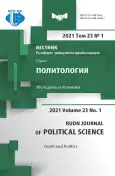Социальный капитал молодежи современного мегаполиса: возможности эмпирического исследования
- Авторы: Шентякова А.В.1
-
Учреждения:
- Санкт-Петербургский государственный университет
- Выпуск: Том 23, № 1 (2021): Молодежь и политика
- Страницы: 130-140
- Раздел: МОЛОДЕЖЬ: СОЦИАЛЬНЫЙ И ПОЛИТИЧЕСКИЙ КАПИТАЛ
- URL: https://journal-vniispk.ru/2313-1438/article/view/322137
- DOI: https://doi.org/10.22363/2313-1438-2021-23-1-130-140
- ID: 322137
Цитировать
Полный текст
Аннотация
Современный мегаполис представляет собой конгломерат, который концентрирует экономические, политические, культурные, информационные и человеческие ресурсы. Высокая плотность населения, экономические и географические условия, сложная полиэтническая и мультикультурная структура крупных городов способствуют формированию определенных типов ценностных установок и поведенческих моделей у представителей молодого поколения. В качестве методологической основы выбраны неоинституциональный подход и теория социального капитала. Рассматривается ряд методологических работ, посвященных различным аспектам категории «социальный капитал», и исследуется возможность использования этого концепта для анализа мотивации протестного поведения и оценки протестного потенциала молодых людей. Сочетание экономической модели многоуровневого анализа социального капитала С.А. Сысоева и социально-политических параметров для эмпирической части исследования позволило четко определить основные категории и индикаторы анализа. Измерение уровней социального капитала мегаполиса с включением сетевого компонента расширяет диапазон возможностей для оценки и выявления протестного потенциала жителей крупных городов России.
Об авторах
Анна Владимировна Шентякова
Санкт-Петербургский государственный университет
Автор, ответственный за переписку.
Email: a.shentyakova@spbu.ru
кандидат политических наук, ассистент кафедры политических институтов и прикладных политических исследований
Санкт-Петербург, Российская ФедерацияСписок литературы
- Afanasyev, D. V., Guzhavina, T. A., & Mekhova, A. A. (2016). Social capital in a region: Revisiting the measurement and building of an indicator model. Economic and Social Changes: Facts, Trends, Forecast, 6: 110–125. (In Russian).
- Akhremenko, A. S., Stukal, D. K., & Petrov, A. P. (2020). Network vs message in protest diffusion on social media: Theoretical and data analytics perspectives. Polis. Political Studies, 2: 73–91. (In Russian).
- Akhtarieva, L. G., & Kharichkova, L. I. (2016). Current trends in the development of Russian megalopolises. Fundamental Research, 7: 56–57. (In Russian).
- Bourdieu, P. (2002). Forms of capital. Economic Sociology: E – Journal, 3–5: 60–74. (In Russian).
- Bourdieu, P. (2004). Forms of capital. Moscow: ROSSPEN. 680 p. (In Russian).
- Coleman, J. (2001). Social and human capital. Social Sciences and Contemporary World. 3: 122–139. (In Russian).
- Di Maggio, P. (1982). Cultural capital and school success: The impact of status culture participation on the grades of U.S. high school students. American Sociological Review, 47: 189–201.
- Franz, V. A. (2020). “Soft power” of the culture of political protest: Theoretical and methodological foundations of the study. Philosophy and Humanities in Information Society, 2: 92–101. (In Russian).
- Fukuyama, F. (2002). Social capital. Culture matters. How values contribute to social progress. Ed. by L. Harrison and S. Huntington. Moscow.: Moscow school of political research. 320 p. (In Russian).
- Khaikin, M. M., & Krutik, A. B. (2014). Social capital and social networks. Bulletin of the South Ural State University. Series Economics and Management, 1: 85–92. (In Russian).
- Levanova, E. A., Mudrik, A. V., Pushkareva, T. V., & Seryakova, S. B. (2019). Megapolis as a socio-cultural and socio-pedagogical phenomenon. Siberian Pedagogical Journal, 5: 7–14. (In Russian).
- Maksimov, S. N., & Semenenko, V. V. (2012). Peculiarities and problems of the development of contemporary megalopolises. Problems of Modern Economics, 2: 352–355. (In Russian).
- Maskell, P. (2000). Social capital, innovation and competitiveness. Social Capital, Critical Perspectives. S. Baron, J. Field, T. Schuller (Eds.), Oxford: Oxford University Press. 111–123.
- Naydenova, L. I., & Fedotov, L. N. (2009). Non-economic capital and its implications for regional social development. The Journal of Sociology and Social Anthropology,12(2): 84–95. (In Russian).
- Parshina, V. V. (2015). Youth as a special socio-demographic group in the social structure of society. Actual Problems of Humanities and Natural Sciences, 10(5): 114–117. (In Russian).
- Putnam, R. (1996). Making democracy work: Civic traditions in modem Italy. Moscow: Ad Marginem. 287 p. (In Russian).
- Seredina, M. I. (2011). Social problems of contemporary world’s megalopolises. SERVICE PLUS, 1: 23–27. (In Russian).
- Stolbov, V. P. (2016). About social capital in urban environment. Proceedings of the Universities. Series Economics, Finance and Production Management, 4(30): 71–72. (In Russian).
- Vlasov, F. B., & Stebakov, A. A. (2016). Types and contradictions of social capital. Society and economy, 10: 20–21. (In Russian).
- Zakharov, A. (2018). Criticism of the concept of “Social capital” (translated from English by A. Zakharov). Emergency Reserve; 3: 211–220. (In Russian).
Дополнительные файлы









